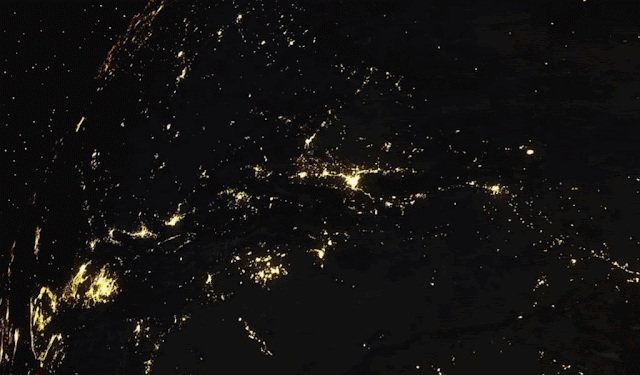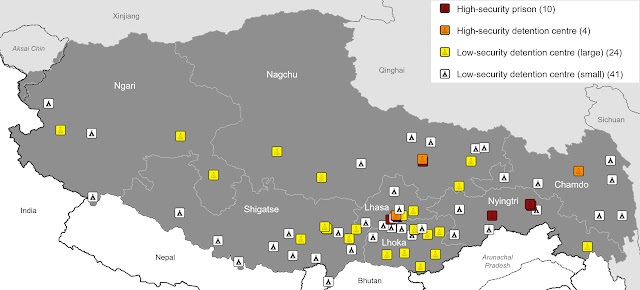What night-time lighting tells us about Tibet's Chinese prisons and detention centres
Chinese Authorities in Tibet are engaging in preventive repression towards their population.
As part of their nationwide 'stability maintenance' strategy, they are detaining, persecuting and convicting Tibetans for non-violent forms of protest and other expressions of dissent such as assisting or supporting self-immolations and carrying pictures of the Dalai Lama.
The precise workings, nature and scale of the Chinese Communist Party's efforts to imprison and detain Tibetans, however, remain poorly understood.
In contrast with the body of knowledge on the detention and imprisonment of Uyghurs and other ethnic minorities in Xinjiang, the Tibetan detention system is still very much a black hole to the international community. The lack of evidence on many issues, especially on the so-called 'vocational training centres' and detention through the criminal justice system, is not evidence of the absence of repression. Rather, it highlights a need for further research to address many of the research gaps and to better understand the situation.
This study therefore aimed to build on the scant available evidence and leveraged an innovative method — night-time lighting data — to shed light on the prisons and detention facilities in Tibet.
Measured on a daily basis using satellite-based sensors, night-time lighting data represent an equilibrium measure of electricity consumption at night at specific locations over time. Aggregated into monthly trends, these data can help illuminate potential changes in the construction, growth or decline in the use of specific detention facilities across Tibet that may not be visible using overhead satellite imagery alone.
Key findings
We found that there are currently at least 79 prisons and detention centres throughout Tibet, with most towns and villages having a detention centre.
We began with a publicly available dataset of 83 known detention facilities from the Tibet Research Project (TRP). Using historical satellite imagery of these locations, we developed a coding scheme to classify these facilities by level of securitisation and purpose. We also excluded facilities that did not fit neatly into the mould of a prison or detention centre, leaving 79 known prisons or detention centres for analysis.
The majority of these are assessed to be small, low-security detention centres which most likely provide low-level detention and short-term jail functions.
Using publicly available satellite imagery from Google Earth, we developed a coding scheme to differentiate these 79 facilities by level of securitisation and purpose, informed by RAND's prior research in Xinjiang and TRP's underlying facility classification. As a result, we identify four overall types of facilities across the Tibet Autonomous Region (TAR):
We assess that the majority of facilities (41 out of 79) identified by TRP are small, low-security detention centres. These facilities exhibit a similar imagery signature to the example shown below, with two watchtowers in opposite corners of the compound and minimal support infrastructure surrounding the secured portion of the compound. Given the small size of these facilities, their limited security (only two watchtowers), the lack of supporting infrastructure and their often urban location, these facilities likely provide low-level detention and short-term jail-like functions across the TAR.
Almost all of these facilities were built before 2011, when Tibet's former Party Secretary Chen Quanguo (also known as the architect of repression in Tibet and Xinjiang) came to power in Tibet.
Our analysis of overhead satellite imagery suggests that 86 per cent of all detention facilities in the TAR were built by 2011 at the latest, although this is an imperfect measure owing to gaps in the availability of archival imagery before this date. This figure is based on the first year in which specific detention facilities are visible in available commercial satellite imagery — an imperfect measure of the date of construction, but still instructive in assessing when widespread Tibetan detention was first conceived and implemented.
Although we cannot rule out the possibility that Chen may have repurposed existing facilities for political purposes upon his arrival, we can hypothesise (but not conclude) that the construction of these facilities reflects policy and managerial objectives rather than one individual's leadership style.
Most Tibetan detention facilities are already visible in imagery by 2011, well before night-time lighting data are available
Since Chen's tenure, the overall size and scale of the Tibetan detention system has been relatively stable, which suggests ongoing continuity in government policy.
Besides overhead satellite imagery, we also used night-time lighting data to better understand the development of Tibet's detention system over time. Night-time lighting provides an equilibrium measure of electricity consumption at night at specific grid coordinates and serves as a useful proxy for levels of activity at specific facilities over time. We found that at the aggregate level, at no time do the night-time lighting data show a clear inflection point which would indicate a massive expansion or reduction in Tibet's detention system beyond its existing footprint, which would normally reflect a major policy change.
Night-time lighting data across Tibetan detention facilities reveal no clear inflection points in growth or decline
However, this does not necessarily mean that the Chinese Communist Party's approach towards imprisoning and detaining Tibetans has remained the same since 2014.
Zooming in on individual facilities, we see for instance that recent patterns of growth in night-time lighting have been concentrated in higher-security facilities since 2019. This trend suggests a possible shift towards longer-term imprisonment and detention of Tibetan dissidents as opposed to shorter-term detention.
While we conducted a preliminary and exploratory investigation in this study, this mode of research could be extended further and even approached from the opposite direction.
Our analysis restricted itself to the study of facilities already identified by TRP and subsequently worked to create means for classifying them and measuring their evolution. Approached from the opposite direction our classification schema could, in principle, form the basis for modelling efforts targeted at identifying additional facilities that share observable characteristics with those studied here. Any such effort would be a significant undertaking but may yield additional insights into the full extent of 'stability maintenance' activities in Tibet and beyond.
Satellite imagery and night-time lighting analysis, however, only addresses a subset of what is a complex and dynamic problem.
Other areas, such as understanding the conditions inside facilities and imperceptible forms of control, deserve further attention. Some of these topics may best be tackled by government agencies or other members of the research, policy, and advocacy communities, given changes in the information environment in China. Irrespective of who might be best placed to further our understanding in each area, we urge practitioners to view this field of research as multidimensional, with distinct segments of research, analysis and information-gathering being treated as complements rather than substitutes.









Comments
Post a Comment